10 Most Famous Landscape Paintings
Throughout history landscape painting always struggled for recognition and it was not until the 17th century that it truly started to be appreciated.
Prior to this historical, religious and portraits of the rich and powerful dominated the art world.
However, it was during the 18th/19th century that the genre really institute favor, movements such as Impressionism, the Hudson River School and the two great English artists Turner and Lawman made landscape paintings extremely sought after.
Beneath is a list of some of the most famous landscape paintings ever produced.
Famous Landscape Paintings
1. Impression Sunrise
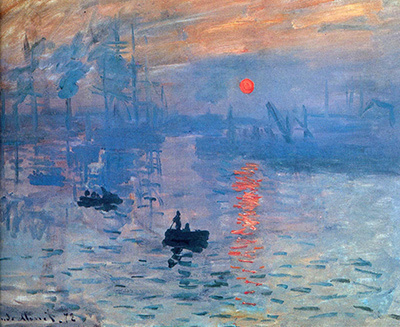
Impression Sunrise is one of a series of paintings by Monet that depicts the port of Le Harve, France.
Le Harve is actually his home town and he would pigment six separate canvases of the landscape scene.
The painting itself actually gives rise to the naming of the fine art move "impressionism".
The Impressionists and their art were initially not well received by the Paris art institution.
With Louis Leroy, a prominent critic of the time, maxim that the wallpaper was more finished than the paintings of Monet.
They were and then resolutely rejected that, after being rejected from the Paris Salon in 1874, it drove the group of artists to hold their own exhibition.
Ironically, Impression Sunrise has a much more restrained use of castor strokes and more subdued colors than the paintings that would continue to personify the motion, equally such it is not really a good example of impressionism.
Monet is famed for his many mural paintings, he would routinely paint the same scene multiple times in varying lighting conditions.
A stiff advocate of 'en plein air' or painting outside he would often have multiple canvases with him when working in the fields effectually his firm in Giverny.
Other great works that he completed in this manner are his Haystacks series and Water Lilies series all of which would have painted outside with some of them completed in the studio later.
ii. Starry Night

Van Gogh is not only famous for his art but likewise for cutting off his ain ear.
Van Gogh spent a considerable portion of his life suffering from low and anxiety and following the human action of cut his ear he voluntarily admitted himself to the Saint-Paul-de-Mausole lunatic asylum, virtually Saint-Remy-de-Provence on 8 May 1889
In the aviary of Saint-Paul-de-Mausole he would feel one of his about productive periods equally an creative person when he made some of his most famous paintings, such equally Irises and his cocky-portrait in blueish.
He painted The Starry Night during this time, which was the view from his east facing window in the aviary.
Information technology is non an exact reflection of the view from his window, rather a combination of different elements of the various landscapes he had observed throughout his life.
All of which culminate in the final painting, but before sunrise, the prototype reflects his view of an ideal village.
iii. The Hay Wain
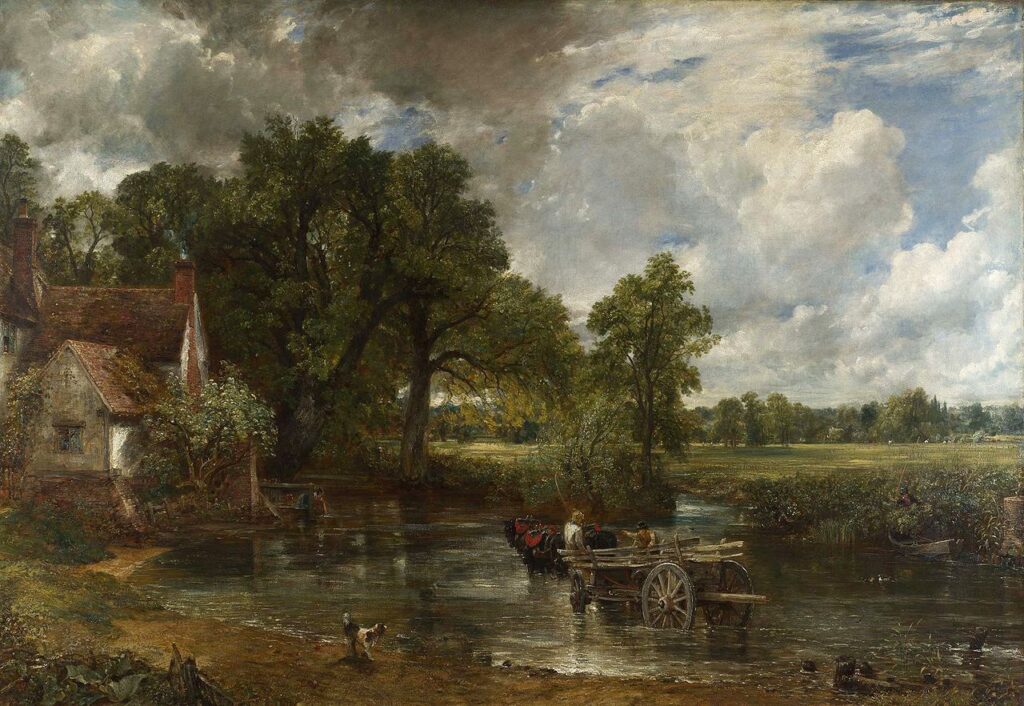
The Hay Wain is a painting by British artist John Constable, completed in 1821, depicting a rural scene between the English counties of Suffolk and Essex, on the River Stour.
Constable is one of the swell landscape artists and forth with William Turner his art is always what springs to mind when people think of English landscape paintings.
The Hay Wain is one of Lawman 's drove of paintings called the 'half-dozen-footers', big-scale canvases that he produced for the Majestic University's almanac summer exhibitions.
Initially it was not very well received in England at the time both the style of painting the "impasto" technique nor the field of study matter.
The painting is a scene of an everyday idyllic life in the countryside, when in reality at the time life in the British countryside was far from perfect.
The industrial revolution would render many farm hands out of work and there was a mass exodus from the countryside towards any available piece of work in the cities and larger towns.
Prior to this work the majority of landscape ark would have been painting in a more symmetrical way and would accept been of a classical setting similar to the works of Claude Lorrain.
It is arguably his nearly famous piece of work and currently resides on permanent display in the National Gallery in London.
four. Christina's Globe
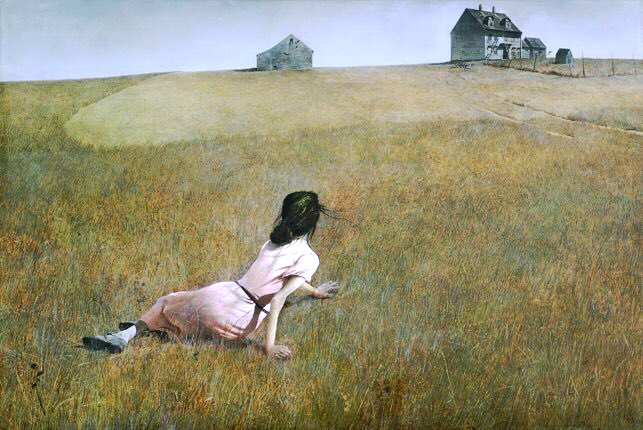
Andrew Wyeth was 1 of the best known American artists who was fabricated famous for documenting the lad and people around him, he would be primarily be considered a realist painter yet he thought of himself equally more of an abstractionist artist.
The adult female in Christina's world is a immature lady past the name of Anna Christina Olson of South Cushing, Maine which is where his married woman betsy'southward family owned a home.
Wyeth would paint many works in both Maine and Chadds Ford, Pennsylvania, where he was born, oftentimes capturing everyday rural scenes.
The inspiration for Wyeth's most famous painting was Anna, who had a degenerative muscle affliction that toll her the use of her legs in her early 30s.
Wyeth claims he was inspired to paint her after seeing from his window her crawl across a field.
Information technology is one of the most iconic landscape paintings by a 20th century artist which ironically received very piffling if any attending when it was first displayed.
five. Wanderer In a higher place the Sea of Fog
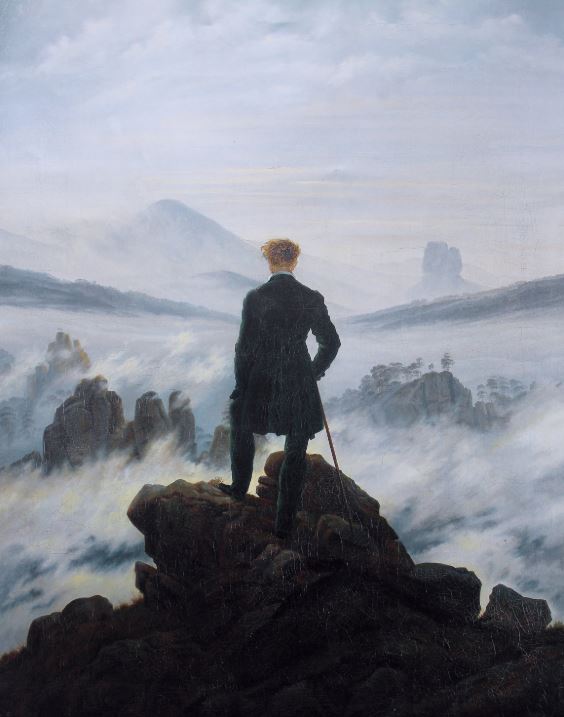
Der Wanderer über dem Nebelmeer (Wanderer above the Sea of Fog) is an oil painting past the German Romantic artist Caspar David Friedrich dating from 1818.
It has been regarded every bit one of Romanticism's masterpieces and one of its most representative works.
A lone figure stands atop a mountain peak gazing out across a fog laden backdrop, it is extremely contemplative in nature and represents the wanderer looking towards the unknown future that stands before him.
Besides Read: Famous Mount Paintings
Unfortunately this is one of his works that was adopted by the Nazi party who used it equally a symbol of strong German nationalism, information technology wasn't until the 1980's that he would eventually exist gratuitous of the association and his work started to be appreciated over again.
vi. The Oxbow
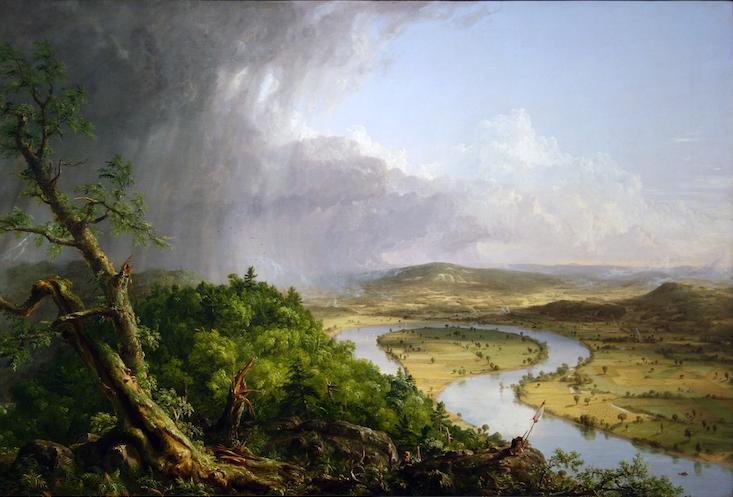
Or to requite it it's total title "View from Mount Holyoke, Northampton, Massachusetts, afterward a Thunderstorm — The Oxbow" was painted by Thomas Cole in 1836.
Cole was the founding fellow member of the Hudson River School(not technically a school more of a motility)
The Hudson River School was an American art movement in the mid-19th century, represented by a group of mural painters whose Romanticism inspired their artistic vision.
The paintings, including the Catskill, Adirondack, and White Mountains, usually stand for the Hudson River Valley and the surrounding area.
Too Read: Famous Waterfall Paintings
Cole was built-in in Lancashire, England and moved to America when he was seventeen.
Whilst to the uninformed the Oxbow may seem similar a perfectly idyllic landscape image there is really quite a chip more to it.
There is actually a very stiff contrast betwixt the wilderness of the natural world and the advance of civilization.
On the colina in the background there are very deliberate logging scars cut into the hill and the middle footing on the right of the picture is nigh all cultivated state where the previous forests have been felled to make style for farmland.
vii. Breezing Upwardly (A Fair Wind)
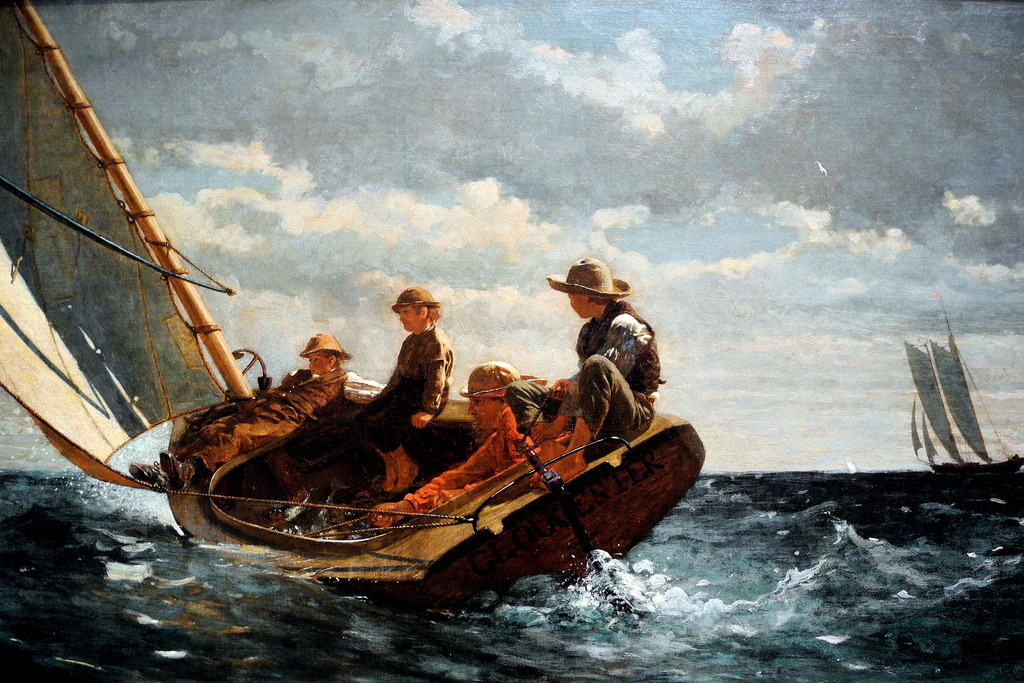
Breezing Upward (A Off-white Wind) is one of Winslow Homer's most celebrated landscape paintings. Homer initially started out as a commercial illustrator and worked for many leading publications of the day such as Harper's Weekly.
It was his assignments with Harper's Weekly that would trust him headlong into the civil war as he would visit several camps of the Northern troops.
Also Read: Famous Ceremonious War Paintings
He sketched and engraved everyday scenes and ordinary soldiers while in these camps and capturing these images would propel him forward towards a career equally a painter.
Afterwards a trip to France where he was exposed to Realist artists such as Manet and Courbet he focused heavily on capturing everyday life scenes of American life.
A Breezing Up on the surface seems like a rather simple capture of a father and his sons on a small angling gunkhole. However, the look on the fathers face is rather stern and is a direct dissimilarity to the youthful and joyous look on the children's faces.
The composition shows a clear influence from his fourth dimension in France with the master subjects shown in a very close up way in the foreground and a juxtaposition with the larger sail gunkhole far off in the background.
8. Fine Wind, Articulate Morning time
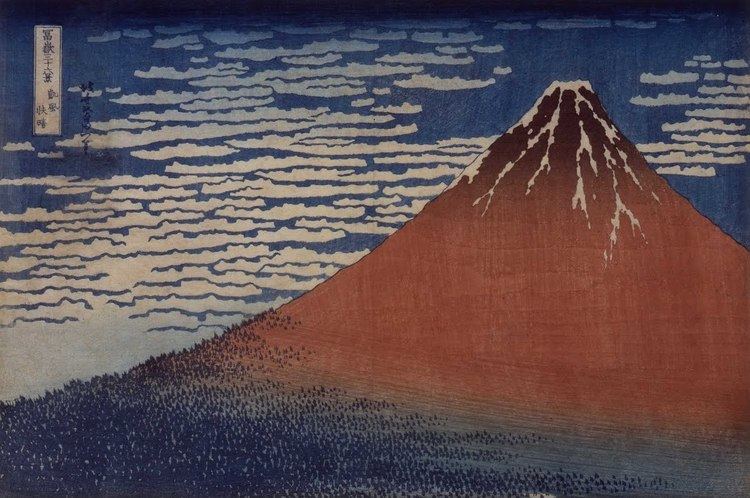
Fine Wind, Clear Forenoon is a painting by the famous Japanese artist Katsushika Hokusai of the Edo flow(betwixt 1603 and 1868), who is most famous for his series of landscape prints.
His other notable works are The Great Moving ridge and and Rainstorm Beneath the Summit all of which class part of a serial called Thirty-half dozen Views of Mountain Fuji(which are actually 46 in total.)
Mountain Fuji was revered within Japanese culture and is the subject of millions of paintings, drawing and prints to have been produced.
The prints are created by a procedure that involves drawing the image on thin Japanese paper(washi), gluing the paper to the cake so using the newspaper every bit a guide to carve a woods block which is virtually frequently cut from cherry as information technology has a really fine grain.
One time glued to the cake an incision was then made forth each side of the line on the paper to give a line of varying thickness which was then chiseled away.
The block was then inked and so pressed to form the paradigm. The simplest examples were in black and white adding color increased the difficulty and the fourth dimension to complete the work significantly.
ix. Looking Down Yosemite Valley
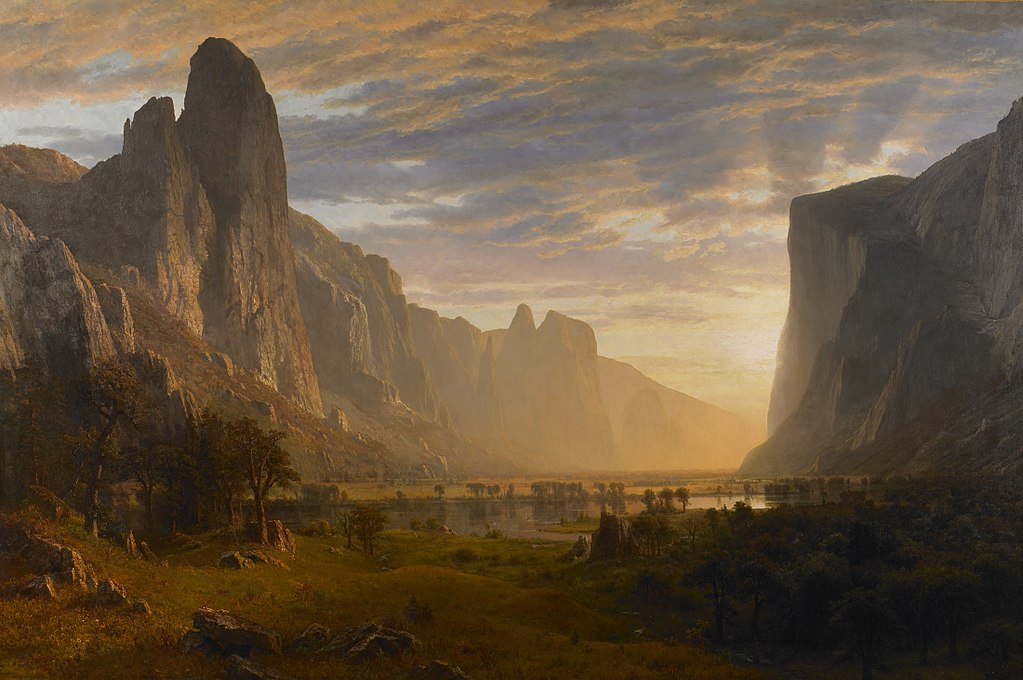
Looking Down Yosemite Valley was painted by Albert Bierstadt in 1865 and is a particularly big canvass measuring over 5 x 8 anxiety.
It is the painting that Bierstadt would go most known for and cemented him as 1 of the best American artists of the day.
Although he was originally born in Deutschland Bierstadt is usually considered every bit American having moved there every bit a child at the young age of one twelvemonth sometime.
Looking Down Yosemite Valley was painted in 1865 only Bierstadt had actually made several preparatory sketches in 1863 whilst on a trip out due west with his future wife.
This practice of sketching out in the wild and completing the works in the comfort of his studio is something that he would continue to exercise for most of his career. One of his other famous pieces Among the Sierra Nevada, California was actually completed in his Rome studio while on a ii yr tour of Europe.
Bierstadt'southward work received great commercial success with lot's of his work being bought for very large sums of coin, all of this cash immune him to travel extensively through Europe, he fifty-fifty had a private audition with Queen Victoria.
Looking Downwardly Yosemite Valley is i of the finest pieces of landscape art that he produced and it essentially captures a very natural looking Yosemite free from the advances of man w.
Bierstadt choose to paint the scene devoid of any humans or animals and there is a very romantic look to the sail that draws the viewer from the artists centre correct through to the background, nevertheless the groundwork is void of whatsoever real focal point instead a golden brume spreads light out across the valley.
To many it captured the ideal image of the untouched Western landscape before a time when man started to heavily populate the surface area.
He would render several years later on in 1867 and was saddened by the amount of tourists that he plant in the wilderness who were brought in big numbers by the completion of the Transcontinental Railroad.
x. The Fighting 'Téméraire' Tugged to her Last Berth to exist Broken Up
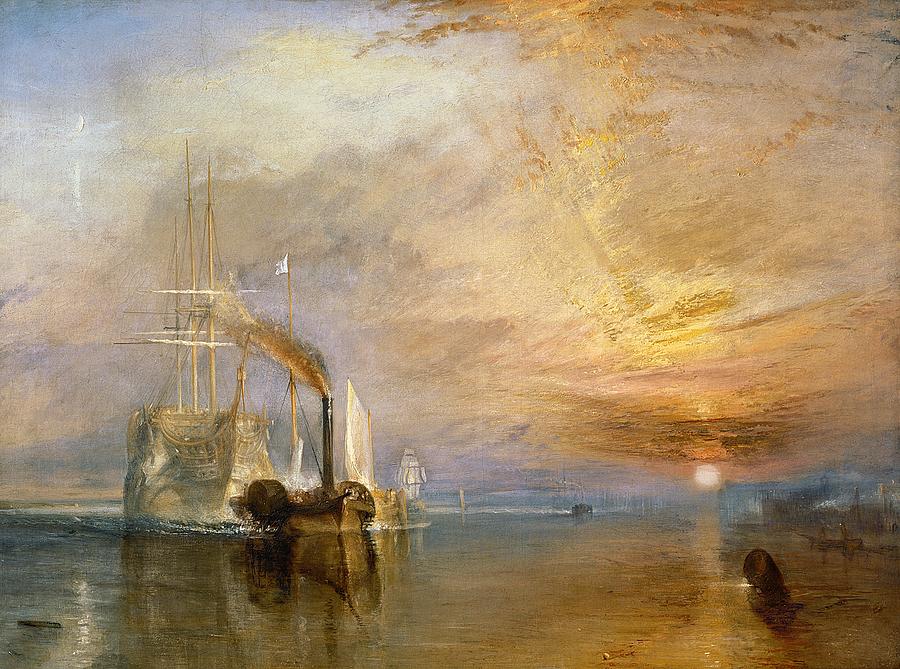
Along with John Constable, J.M.W Turner is responsible for some of the nigh famous landscape paintings ever produced by any English man.
Turner is know for is rather atmospheric paintings of the sea and the surrounding coastline with a particular focus on the effects of lite.
All big volume of his piece of work was centered around the River Thames in London and would consummate thousands of sketches of such scenes with a view to completing them later on in his studio.
Also Read: Famous River Paintings
The Fighting Temeraire, tugged to her last berth to exist cleaved up was painted by Turner in 1838
From her valiant success at Trafalgar, The Temeraire was a very well-known ship and her sale by the Admiralty received considerable press coverage, which was possibly what brought it'south plight to his attending.
On five September 1838, Turner witnessed the ship on a tow while boating off the Greenwich marshes, it would somewhen stop upwardly in a breakers yard where Turner would make more detailed sketches of the hull.
The significance of the tug is non to exist understated as it was steam powered and as such symbolized the new dawn of steam power and the demise of the gilt age of sail power.
From a compositional stand point the old at present defunct sailing send that once was a symbol of British naval power is positioned to the side and information technology is the newer steam powered tug with it's muddied chimney belching out thick smoke that is closer to middle.
We promise you accept enjoyed our list of some of histories all-time landscape paintings!
durochermovenciought1948.blogspot.com
Source: https://www.artst.org/famous-landscape-paintings/
0 Response to "10 Most Famous Landscape Paintings"
Post a Comment